Overview Suntan, melanoma and vitamin D
Consensus on the following:
UV radiation at the ground consists mainly of UVA, some UVB, and a tiny amount of UVC
Sun, sunbeds/tanning beds/some sun bulbs contain both UVA and UVB radiation
UVA (315 -400 nm) radiation induces pigment tanning within seconds of UVA and light exposure
- UVA tanning fades within 2 hours and does not increase melanin in skin
UVB (280-315 nm) radiation
induces vitamin D synthesis
delayed tanning (increases melanin in skin after several days)
is mainly responsible for sunburn (erythema), photoaging, photoimmunosuppression
Windows (glass) block UVB radiation
Modern sunscreens block UVB and UVA, but some of them block UVA poorly or are photo-unstable in this region
There has been an increase in melanoma incidence in recent years
Tanning beds produce higher levels of UVA radiation than the sun - even at the equator
UVB radiation, but not UVA radiation, induces melanoma in genetically modified animals
- The newest epidemiological evidence suggest that UVA as well as UVB is associated with human melanoma
Epidemiological studies published over the last years demonstrated the association between sunbed use and melanoma.
Many countries restrict the amount of UVB (vitamin D) from tanning beds (due to mouse study)
UVB decreases faster than UVA when far from equator or winter season
Confusion/Disagreement
Sunburn (Erythema), cataracts, and development of skin cancer are related mostly to UVB radiation.
Ban all people under age 18 from using tanning beds
Increase alcohol consumption is strongly associated with increased melanoma (see bottom of page)
Note: After skin cancer diagnosis, internal cancer rates often increase due to sun phobia
See also VitaminDWiki
Melanoma 2.1 X more likely if low vitamin D – meta-analysis Jan 2020
Sunburning reduced by 200,000 IU of Vitamin D – RCT April 2017
Skin cancer (in mice) due to UV was prevented by vitamin D (active, topical) – June 2016
Thin epidermis under skin cancer was thickened when vitamin D was raised to 70 ng – April 2014
Fewer heart attacks, hip fractures and deaths if more skin cancer – Sept 2013
- Skin cancer is a proxy for getting more UVB ( Vitamin D)
Melanoma not as thick if recently had a sunny vacation – Nov 2013
AAP Issues Guidelines on Limiting Sun Exposure in Children – Feb 2011
Perhaps 28-40 ng of vitamin D would be good for Melanoma patients – Feb 2011
If avoiding sun for medical reasons, you need oral vitamin D – April 2011
Possible DNA damage of skin if vitamin D levels lower than 20 nanograms – April 2012
Overviews of Cancers (including Melanoma) by Vitamin D Council
A life history perspective on skin cancer and the evolution of skin pigmentation Jan 2014 PDF is at the bottom of this page
- Compares various ideas about skin cancer and pigmentation
Vitamin D from phototherapy lamps, tanning beds, and the sun – Jan 2012 has the following chart
- Note Blue area is < 1,000 IU per day from UVB with full body exposure

Death from melanoma (without ulcers) greatly decreased if have lots of vitamin D receptors – May 2014 has the following chart
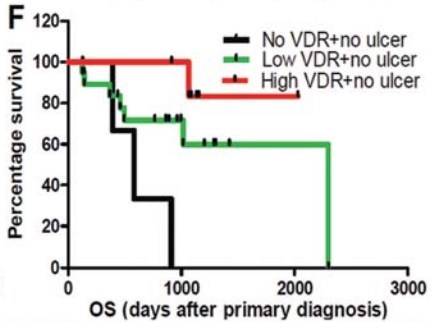
See also VitaminDWiki UVA and Melanoma
UVA causes skin cancer, perhaps UVB (Vitamin D) prevents skin cancer – Jan 2017
Melanoma is 44 percent LESS LIKELY if get sun on the job – Nov 2013
Hypothesis – worldwide increase in Melanoma due to UVA – Oct 2011
Indoor Tanning Boosts Chances of Melanoma - perhaps because of UVA in some tanning beds
Hypothesis: UVA through window glass decreases vitamin D - 2009
30+ UV pages have MELANOMA or CANCER in the itle
This list is automatically updated
{LIST()}
42+ pages have MELANOMA in the title
This list is automatically updated
{LIST()}
See also web
Vitamin D and malignant melanoma - April 2022
- A consideration of possible effects of Vitamin D on established cancer, with reference to malignant melanoma 📄 PDF
90 % of Melanoma Surgeries are Unnecessary Nov 2012
- reporting on study in Journal of the American Academy of Dermatology"300,215 melanoma excision cases. 10 years, 13 countries.
- Cutaneous melanoma: how does ultraviolet light contribute to melanocyte transformation? 2008
- "Ascribing a causal role to ultraviolet radiation in melanoma induction is problematic, as the relationship between total lifetime sun exposure and melanoma risk is not as strong as for some other skin cancers."
- Low Serum 25-Hydroxyvitamin D Concentrations Are Associated with Increased Risk for Melanoma and Unfavourable Prognosis Dec 2014
- Low vitamin D thicker skin cancer and shorter life: 80 months vs 195 months - Full text online, PLoS One
- http://aesthetica.com/sunscreen UV vs sunscreen chart
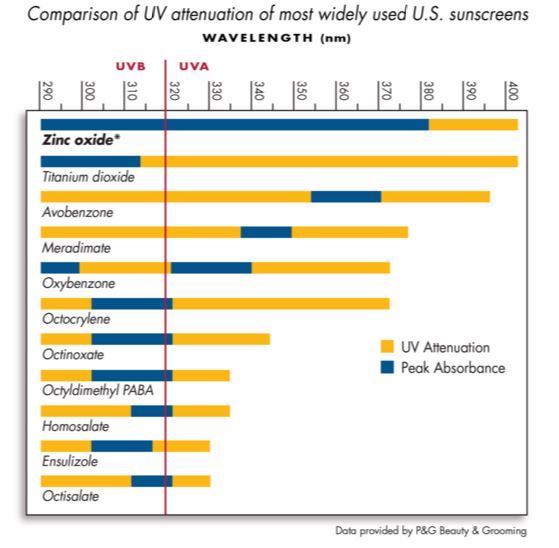
Dermatologists still do not distinguish between types of UVA and UVB nor the amount of UVB needed for Vitamin D before burning
Avoidance - The Most Critical Components of Photoprotection in Patients With Melanoma]
doi: 10.1097/DSS.0000000000002794 Sept 2020
BACKGROUND: Ultraviolet radiation is the main modifiable risk factor for melanoma which can be reduced by avoiding excess sun exposure.
OBJECTIVE : We sought to explore (1) sun protective practices, (2) effectiveness of these sun protective practices, and (3) vitamin D supplementation in patients with melanoma.
METHODS: Using the National Health Interview Survey, the authors conducted a cross-sectional analysis to investigate sun protective behaviors and sunburns among adults with melanoma compared with those without skin cancer. We calculated adjusted odds ratio (aOR), 95% confidence interval (95% CI), and p-values using logistic regression.
RESULTS: Patients with melanoma reported increased use of sun avoidance, shade, sunscreen, long sleeves, and hats, but had similar sunburn rates compared with those without skin cancer. Only sun avoidance and long sleeves were associated with decreased odds of sunburn. Patients with melanoma also reported decreased vitamin D supplementation.
CONCLUSION: Although it is reassuring that patients with melanoma practice sun protective behaviors, this does not always translate into reduced sunburns. Physicians should emphasize the importance of photoprotection, especially sun avoidance and sun protective clothing, to reduce future melanoma risk.
Clipped from SkinCheck org Where does Melanoma occur
Anywhere, including places never exposed to the sun.
In Caucasian males, the most common location is the trunk (especially the back).
In Caucasian females, the most common locations are the legs (especially the back of lower legs) and trunk.
Among Asians, Hispanics, and African-Americans, the most common locations are the feet and hands.
- Skin is lighter (less melatonin), so more UVB can damage the feet and hands
From: Vitamin D from Sunbeds


From: Sunbed survey in Ireland

From: UV creates Vitamin D
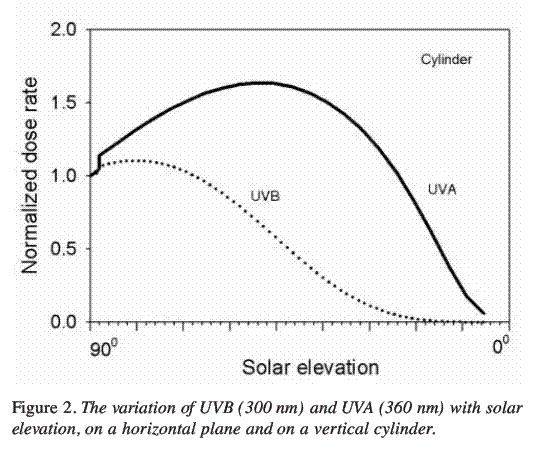
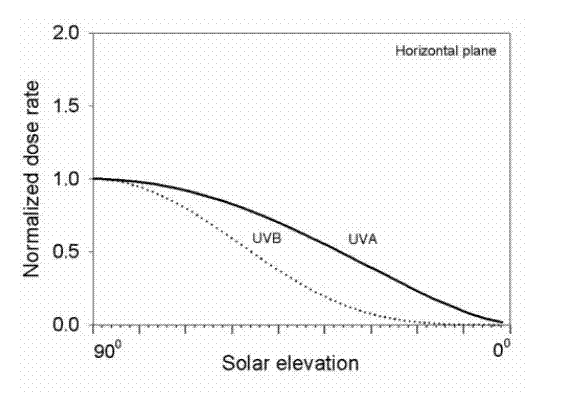
GrassrootsHealth Melanoma & sunscreen associated in 7 studies (PDF and video)

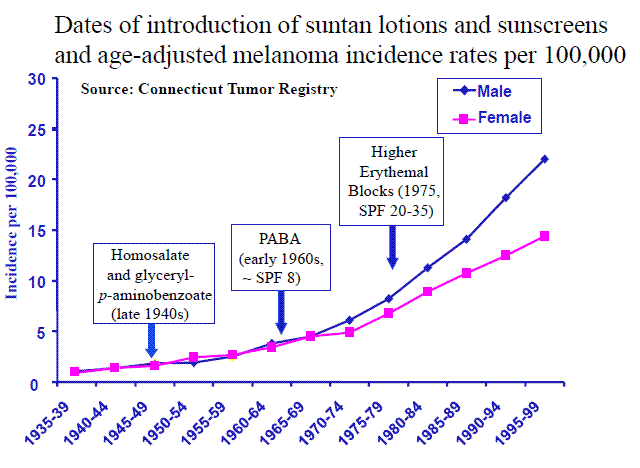
Chart from http://www.detertec.com/sun_radiometry.html
Red = sunlight (probably on ground); other lines = amount of light filtered thru different sunscreens
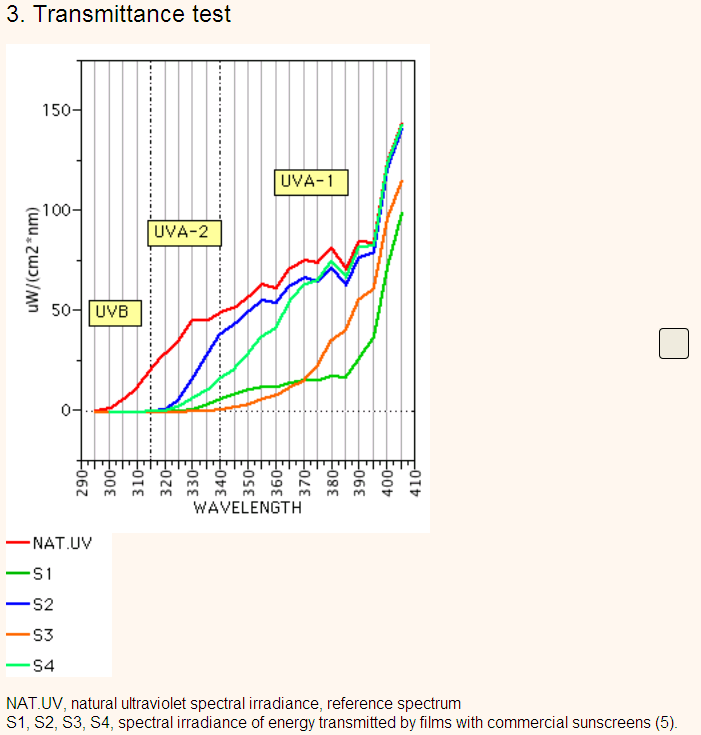
Germany also considers that adding vitamin D might reduce melanoma
Serum 25-hydroxyvitamin D serum levels in a large German cohort of melanoma patients.
Br J Dermatol. 2012 Aug 9. doi: 10.1111/j.1365-2133.2012.11212.x.
Gambichler T, Bindsteiner M, Höxtermann S, Kreuter A.
Department of Dermatology, Ruhr-University Bochum, Bochum, Germany.
Background:? Observational studies have suggested that 25-hydroxyvitamin D (25OHD) is associated with better outcomes in patients with malignant melanoma (MM).
Objectives:? To study the relationship between serum 25OHD levels and clinical parameters in a large German cohort of MM patients.
Methods:? We prospectively investigated the 25OHD serum levels of 764 MM patients using the direct competitive chemiluminescence LIAISON® immunoassay.
MM patients taking 25OHD supplements were not included.
Results:? Median serum 25OHD baseline levels were 12.3 ng/ml (lower quartile: 7.3 ng/ml, upper quartile: 20.2 ng/ml). 564 (764/73.8%) patients had 25OHD deficiency (25OHD < 20 ng/ml), 188 (764/18.8%) had 25OHD insufficiency (25OHD ? 20 < 30 ng/ml), and only 55 (764/ 7.2%) patients had serum 25OHD levels within the normal range (? 30 ng/ml). Using a multiple regression model, lower 25OHD levels were significantly associated with higher Breslow tumour thickness (class: < 1 mm; ? 1 - 4 mm; > 4 mm: regression coefficient -1.45, P = 0.028) and higher AJCC 2002 melanoma stage (regression coefficient: -0.79, P = 0.036).
Conclusions:? In MM patients, decreased 25OHD serum levels are associated with increased tumour thickness and advanced tumour stage.
Hence, evidence is accumulating that patients with MM might benefit from 25OHD supplements.
Some Chinese are really wanting to get whiter skin or avoid Skin Cancer/Wrinkles
Meet the 'Face-Kini', the latest craze to hit China's beaches as bathers wear masks to beat the sun's harmful raysDailyMail UK Aug 2012 - which have photos like the following

Sunshine: Dangerous or Healthy? 2009
- Comment in a NYT interview of Dr. Bernard Ackerman, Demratoligist, who has authored 600 papers
- "the field is just replete with nonsense." For example, Dr. Ackerman does not believe that the link between melanoma and sun exposure (a central dogma of dermatology) has been proven.
- He is deeply tanned and is not afraid to expose his body to the sun. Dr. Ackerman does, however, recommend that folks avoid excessive skin exposure to avoid premature aging of the skin.
- He also does not believe that sunburn, even the kind that causes blistering of the skin, necessarily leads to cancer later in life.
- Basically, according to Dr. Ackerman, "the research is inconsistent and fails to make the case."
Alcohol and Melanoma: More Proof that this Deadly Skin Cancer is not caused by Sunlight
Sunlight Institute, Nov 2013
1993 study: women who drank two or more drinks per day had an increased risk of melanoma of 250% .
Oct 2013 study
- (1) 7+ drinks per week had a 64% increased risk of melanoma;
- (2) higher lifetime alcohol consumption was positively correlated to risk of the disease;
- (3) higher current alcohol consumption similarly correlated to a higher risk:
- (4) current alcohol intake also predicted higher risk;
- (5) a preference for white wine or liquor also predicted increased risk.
- Sunlight Instutiute refutes the claim that melanoma is caused by sunlight
If already have had skin cancer, a form of Vitamin B3 lowers the rate of future ones by 23% - RCT May 2015
- Common vitamin reduces recurrence of some skin cancers Washington Post
- Year-long study in Australia using 500 milligrams of nicotinamide twice a day
- Vitamin B3 provides skin cells with a boost of energy and intensifies the rate of skin repair.
- "It's safe, it's almost obscenely inexpensive and it's widely available,"
- People who haven't been diagnosed with such cancers should not take nicotinamide preventively, she said.
- Results will be presented in late May 2015 at American Society of Clinical Oncology conference in Chicago
- Oral Nicotinamide (A Form of Vitamin B3) Significantly (23%) Reduces Rates of New Non-Melanoma Skin Cancers in Those at High Risk of These Skin Cancers
AI found >99% of skin cancers - Nov 2023
AI flagged skin cancer with near-perfect accuracy, in UK study MD Edge]
"Skin cancer is the most common cancer in the United States; one in five 5 Americans develop skin cancer by age 70."
Study "involved 6,900 patients in the United Kingdom with suspected skin cancer."
